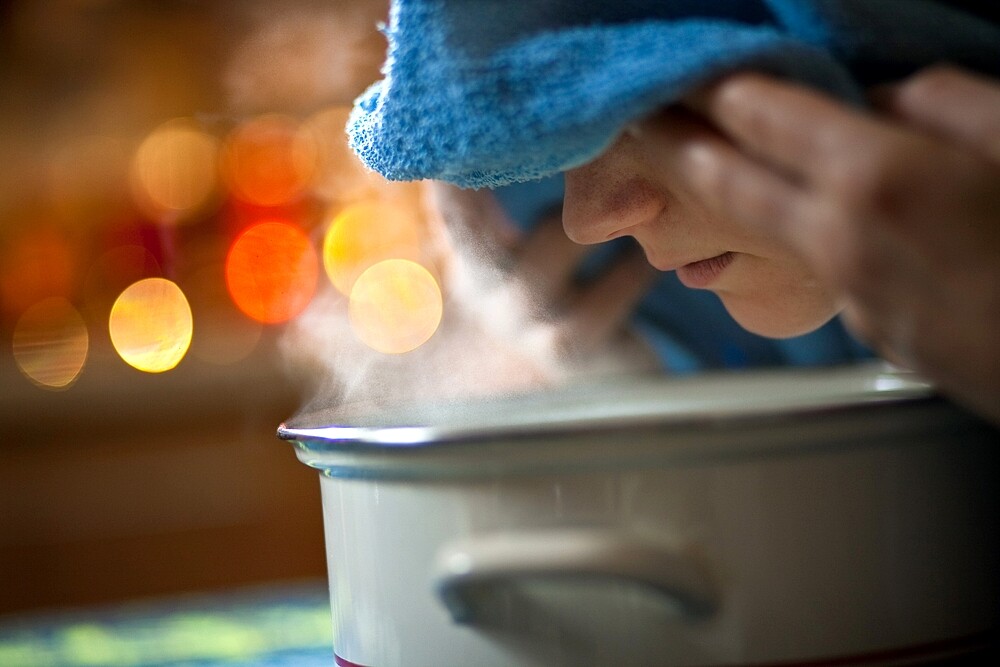Inhalation helps us to clear the airways when we have a cold, cough and so on. How to inhale correctly is explained here.
Why would we inhale?
Inhalation is probably one of the oldest household remedies against colds and is still used today. By inhaling the vapours of chamomile, eucalyptus and co., the mucous membranes of the respiratory tract are moistened in colds – and can thus be released more easily. This can alleviate symptoms such as coughing, because stuck mucus can be coughed up more easily, or when the nose is blocked.
What is inhalation suitable for?
Patients suffering from diseases affecting the upper respiratory tract can benefit from inhalation. The method does not replace treatment with medication (and a corresponding active ingredient), but can alleviate symptoms in a gentle way. Inhalation is suitable for the following diseases and conditions:
- Sinusitis
- Nose clogged
- Sniffles
- Coughing, e.g. due to acute bronchitis
Caution: Inhalation can put a strain on the circulation. If the blood pressure is very low or the circulation is already disturbed in some other way, inhalation should be avoided. The same applies in the event of eye disease or inflammatory skin disease.
Inhale properly: This is how it works
A great advantage of inhalation: anyone can easily perform it at home. The following options are available:
- Inhalation with a pot or a bowl
- Inhalation with an inhaler
How inhalation with a pot or bowl works
- Fill the respective vessel with hot water up to just below the rim.
- Add an inhalation additive. Depending on the symptoms, different variants are suitable here, often the doctor makes a recommendation. Usually chamomile or saline solutions are suitable, in some cases also essential oils (e.g. eucalyptus-based).
- Sit down in front of the table, place a towel over your head and bend over the vessel.
- Keep a distance of about two handbreadths to avoid burning yourself.
- Hold the towel so that no steam can escape to the side.
- Now inhale the steam deeply through your mouth and nose for about 10 to 20 minutes.
- Wash your face with lukewarm water.
- This is good for you and your circulation: After inhalation, do not go outside or expose yourself to draughts. It is best to lie down for a while.
The inhalation can be repeated about two to three times a day. This method only reaches the mouth, throat and nasal mucous membrane, but not the deeper-set bronchi.
How inhalation with an inhaler works
With a special inhaler from the pharmacy and special attachments for the nose and mouth, inhalation becomes even more effective – not only the upper airways but also the bronchial tubes can be reached, which can be particularly helpful in the case of bronchitis. The principle is the same as when inhaling over the bowl or pot: the vapours are inhaled from the device deep into the nose or mouth. The attachments create the so-called active nebulisation, which can influence the size of the water droplets. This is because only tiny droplets reach the bronchial tubes and lungs – and can thus dissolve particularly tough mucus.
Another important piece of information: After use, the inhaler should be rinsed well and dried properly to prevent bacteria from spreading inside.
When can I use essential oil for inhalation?
These products can be used when inhaled with a bowl or pot, but not with an inhaler. If you have allergic asthma, you should not use them at all, as the oils can also irritate the airways and thus trigger an asthma attack. The products should also not be used in children and infants – the ingredients contained in the products, such as menthol, can cause breathing difficulties in small children.

